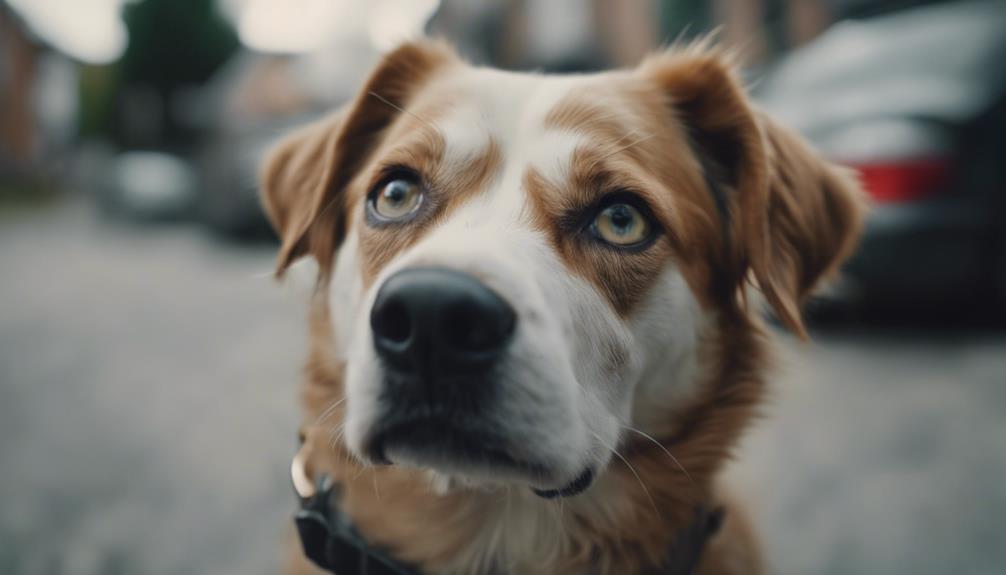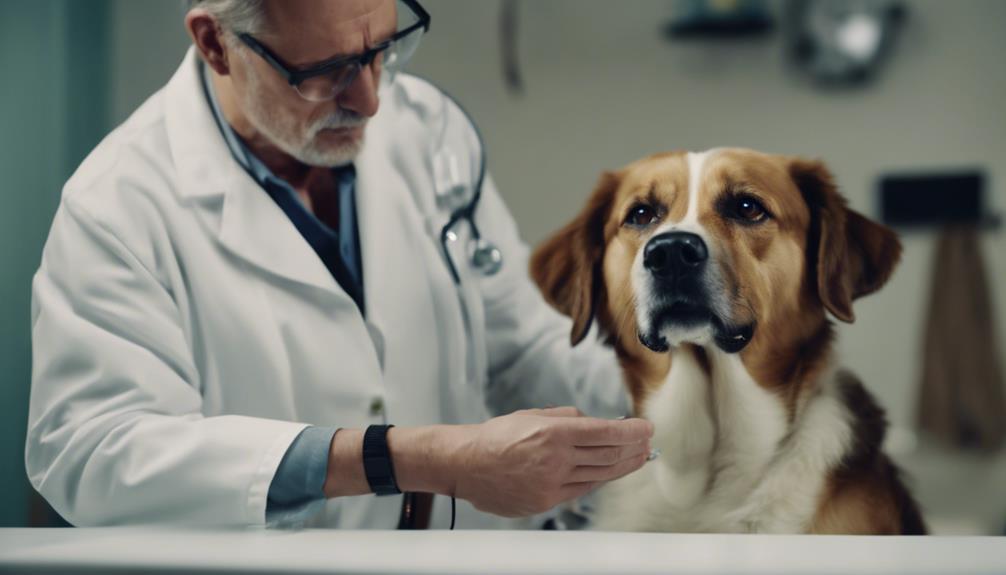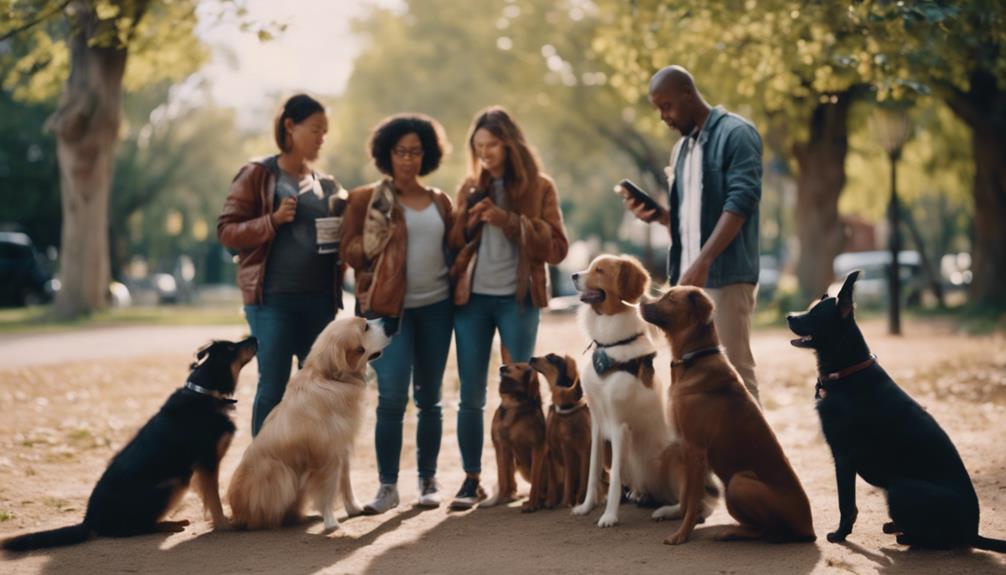Sudden acquired retinal degeneration syndrome (SARDS) presents a challenging scenario for dog owners when their furry companions unexpectedly lose their vision. The abrupt onset of blindness can be disorienting for both the pet and the caregiver, prompting a cascade of uncertainties.
Understanding the initial steps to take, from recognizing the signs to seeking timely veterinary guidance, becomes pivotal in navigating this unforeseen journey. With a blend of medical insights and practical strategies, unraveling the complexities of SARDS and offering support to a visually impaired dog demands a nuanced approach that extends beyond mere adaptation.
Key Takeaways
- Sudden acquired retinal degeneration syndrome (SARDS) causes rapid and irreversible blindness in dogs.
- There is no cure for SARDS, but most dogs adapt well to blindness within weeks.
- Owners can help blind dogs adjust by maintaining routines, providing enrichment, and ensuring safety.
- Specialized tests like electroretinograms (ERG) are crucial for diagnosing SARDS in dogs.
Understanding SARDS in Dogs
Sudden acquired retinal degeneration syndrome (SARDS) is a condition in dogs that leads to rapid onset blindness over a period of days to weeks. This condition is more prevalent in older dogs, typically between 8-10 years of age, and is more commonly observed in spayed females.
While any dog breed can be affected by SARDS, it is more frequently seen in mixed breeds and specific small breeds such as dachshunds, beagles, and pugs. The blindness resulting from SARDS is irreversible as it affects the rods and cones in the retina.
However, it is worth noting that blindness caused by SARDS is not considered painful, and most dogs tend to adapt well to their new visual impairment.
Causes and Research
Understanding the underlying causes of SARDS in dogs is crucial in shedding light on this sudden onset blindness syndrome.
SARDS is considered idiopathic, meaning its specific cause is unknown. It is not believed to be heritable and may involve an immune-mediated response, where the immune system mistakenly attacks the retina. Some theories suggest a potential association with conditions like hyperadrenocorticism (Cushing's disease) or exposure to toxins.
However, no single proven theory or common link has been identified for all cases of SARDS. Ongoing research continues to investigate potential causes of this condition, aiming to unravel the complexities surrounding the development of sudden acquired retinal degeneration syndrome in dogs.
Signs and Symptoms

When observing a dog suspected of SARDS, it is essential to be vigilant for specific signs and symptoms indicating potential vision loss. These signs may include:
- Sudden Vision Loss: Dogs with SARDS experience a rapid progression of vision loss over days to weeks.
- Behavioral Changes: Watch for behaviors such as bumping into furniture, getting stuck in corners, or showing reluctance on stairs.
- Physical Signs: Look out for dilated pupils, signs of separation anxiety, pacing aimlessly, standing still, behavioral changes, and increased dependence on owners.
Being attentive to these signs can help in identifying potential cases of SARDS and seeking timely veterinary care for an accurate diagnosis and appropriate management.
Diagnosis and Tests
Diagnosis of SARDS in dogs involves a comprehensive evaluation of the pet's history, physical condition, and specialized eye examinations. Veterinary ophthalmologists confirm SARDS through an electroretinogram (ERG), which shows a flat line response in the retina to light stimulation. This specific test helps differentiate SARDS from other causes of sudden blindness.
In addition to the ERG, further diagnostic tests such as MRI or CT scans may be necessary to rule out alternative reasons for the dog's vision loss. Specialized eye examinations are crucial in diagnosing SARDS accurately. By combining the pet's history, physical assessment, and these specialized tests, veterinarians can confirm the presence of SARDS and provide appropriate guidance on how to manage the condition.
Treatment and Management

Effective management of SARDS in dogs involves providing support and accommodations to help blind pets adapt to their permanent vision loss. Owners can assist their blind dogs in various ways:
- Maintaining Routines: Consistency in daily routines can help blind dogs navigate their environment more easily.
- Ensuring Safety: Removing potential hazards and creating a safe living space can prevent accidents and injuries.
- Enrichment Activities: Providing toys that make noise or have scents can stimulate blind dogs mentally and physically, enhancing their quality of life.
While there is no cure for SARDS, with time and proper support, most dogs can adjust well to their blindness and continue to lead fulfilling lives.
Immediate Steps to Take
Upon noticing sudden vision loss in a dog, immediate steps should be taken to address the situation promptly and effectively.
The first crucial step is to remain calm and avoid making sudden changes to the environment. Contact a veterinarian immediately to schedule an emergency appointment for a thorough examination.
During transportation, ensure your dog's safety by guiding them carefully and avoiding sudden movements. It is essential to keep your dog in a familiar and safe environment to reduce stress. Avoid rearranging furniture or introducing new obstacles that could potentially harm your blind dog.
Providing comfort and reassurance through gentle touch and familiar sounds can help alleviate your dog's anxiety during this challenging time.
Creating a Safe Environment

To ensure the well-being and safety of a blind dog affected by SARDS, establishing a secure and familiar environment is essential. This can help the dog navigate its surroundings with confidence and reduce the risk of accidents.
Here are three key steps to create a safe environment for your blind dog:
- Remove Hazards: Clear pathways of obstacles and hazards to prevent tripping or collisions.
- Use Scent Markers: Place scented markers around the house to help the dog orient itself and recognize different areas.
- Maintain Consistency: Keep furniture and objects in the same position to maintain a familiar layout for the blind dog.
Behavioral Support for Blind Dogs
When caring for blind dogs affected by SARDS, providing appropriate behavioral support is crucial for their well-being and adjustment to their new reality. Blind dogs can lead fulfilling lives with the right support from their owners. Understanding their behaviors and needs is key to helping them navigate the world without sight. Here are some essential behavioral support strategies for blind dogs:
| Behavioral Support Strategies | Description | Benefits |
|---|---|---|
| Establish consistent routines | Create predictability | Reduces anxiety |
| Use verbal cues and touch | Help orient the dog | Enhances communication |
| Provide mental stimulation | Use puzzle toys | Prevents boredom and promotes mental engagement |
| Encourage physical activity | Short walks or play sessions | Maintains physical health |
| Offer reassurance and affection | Comfort the dog | Strengthens the bond with the owner |
Enrichment Activities for Blind Dogs

Blind dogs affected by SARDS can benefit greatly from engaging enrichment activities that stimulate their senses and mental engagement. These activities can help improve their quality of life and keep them mentally sharp. Here are some enrichment ideas for blind dogs:
- Scent Games: Hide treats around the house for your blind dog to sniff out. This can help enhance their sense of smell and provide mental stimulation.
- Sound Toys: Toys that make noise can be entertaining for blind dogs. Choose toys that squeak, rattle, or crinkle to keep them engaged.
- Tactile Activities: Provide different textures for your dog to explore, such as soft blankets, rubber toys, or textured mats. This can help them navigate their environment and keep them engaged.
Communicating With a Blind Dog
Enhancing communication with a visually impaired canine companion involves utilizing alternative sensory cues and consistent verbal cues. When interacting with a blind dog, it's essential to rely on their other heightened senses to convey information effectively. Here is a table outlining ways to communicate with a blind dog:
| Sensory Cue | Description |
|---|---|
| Touch | Use gentle touches to guide and reassure your dog. |
| Scent | Introduce scents to help your dog identify objects or locations. |
| Sound | Use auditory cues like a specific tone of voice for commands or a bell on their collar. |
Dietary and Health Considerations

To ensure the overall well-being and quality of life for a visually impaired canine companion affected by SARDS, it is crucial to consider specific dietary and health considerations tailored to their unique needs.
Dietary and Health Considerations:
- Specialized Diet: Transitioning to a high-quality, balanced diet suited for dogs with reduced activity levels can help manage weight and overall health.
- Supplements: Consult with a veterinarian to determine if supplements like omega-3 fatty acids or antioxidants could benefit your dog's eye health and overall well-being.
- Regular Vet Consultations: Scheduled check-ups with a veterinarian specializing in ophthalmology can monitor your dog's health, address any concerns promptly, and ensure they receive appropriate care.
Regular Veterinary Check-ups
Regular veterinary check-ups are essential for monitoring the overall health and well-being of dogs affected by SARDS. These check-ups are crucial in managing the condition effectively and addressing any potential complications promptly.
During these visits, veterinarians can assess the dog's overall health status, monitor for any changes in symptoms, and provide necessary interventions or adjustments to the treatment plan. Regular check-ups also allow for ongoing support and guidance for pet owners on how to best care for their blind dog and help them adapt to their new way of life.
Support Groups and Resources

For owners of dogs affected by SARDS, seeking out support groups and resources can provide invaluable assistance in navigating the challenges of sudden blindness and adapting to a new way of life for their beloved pets. When looking for support, consider the following options:
- Online Support Groups: Join online communities dedicated to SARDS in dogs to connect with other pet owners facing similar situations, share experiences, and gain insights on caring for blind dogs.
- Veterinary Referrals: Ask your veterinarian for recommendations on local resources such as specialized trainers, behavioral therapists, or organizations that provide guidance on caring for blind dogs.
- Educational Materials: Explore websites, books, and articles focused on blind dog care to enhance your knowledge and skills in supporting your furry friend through their blindness journey.
Emotional Support for Owners
Understanding the emotional impact of sudden blindness in their canine companions is crucial for owners affected by SARDS. Witnessing a beloved pet lose their vision rapidly can be distressing and overwhelming. Owners may experience a range of emotions, including shock, sadness, guilt, and anxiety about their dog's future.
It is essential for owners to seek emotional support during this challenging time. Connecting with other pet owners who have experienced similar situations, joining online forums or support groups, and seeking guidance from veterinary professionals can provide comfort and reassurance. Taking care of one's mental well-being is as important as caring for the blind dog, ensuring a supportive environment for both the owner and the pet to adjust and thrive.
Deciding on Specialized Care

When faced with the challenges of caring for a dog with SARDS, considering specialized care options becomes imperative for ensuring the well-being and safety of the visually impaired pet. Specialized care can greatly enhance the quality of life for a blind dog. Here are some crucial considerations:
- Consulting a Veterinary Ophthalmologist: Seek a specialist's expertise to assess the extent of your dog's vision loss and discuss potential treatment options.
- Exploring Assistive Devices: Investigate tools like halo harnesses, ramps, and tactile pathways to help your dog navigate their surroundings safely.
- Creating an Enriching Environment: Introduce auditory and olfactory stimulation through toys, scents, and sound cues to stimulate your dog's senses and mental engagement.
Conclusion
In conclusion, SARDS in dogs presents a complex and challenging condition that can lead to sudden blindness. Understanding the causes, signs, and management of this disorder is crucial for pet owners to provide the necessary support for their blind companions.
Regular veterinary check-ups, access to support groups and resources, and emotional support for owners are essential components in navigating the journey of caring for a dog with SARDS.




